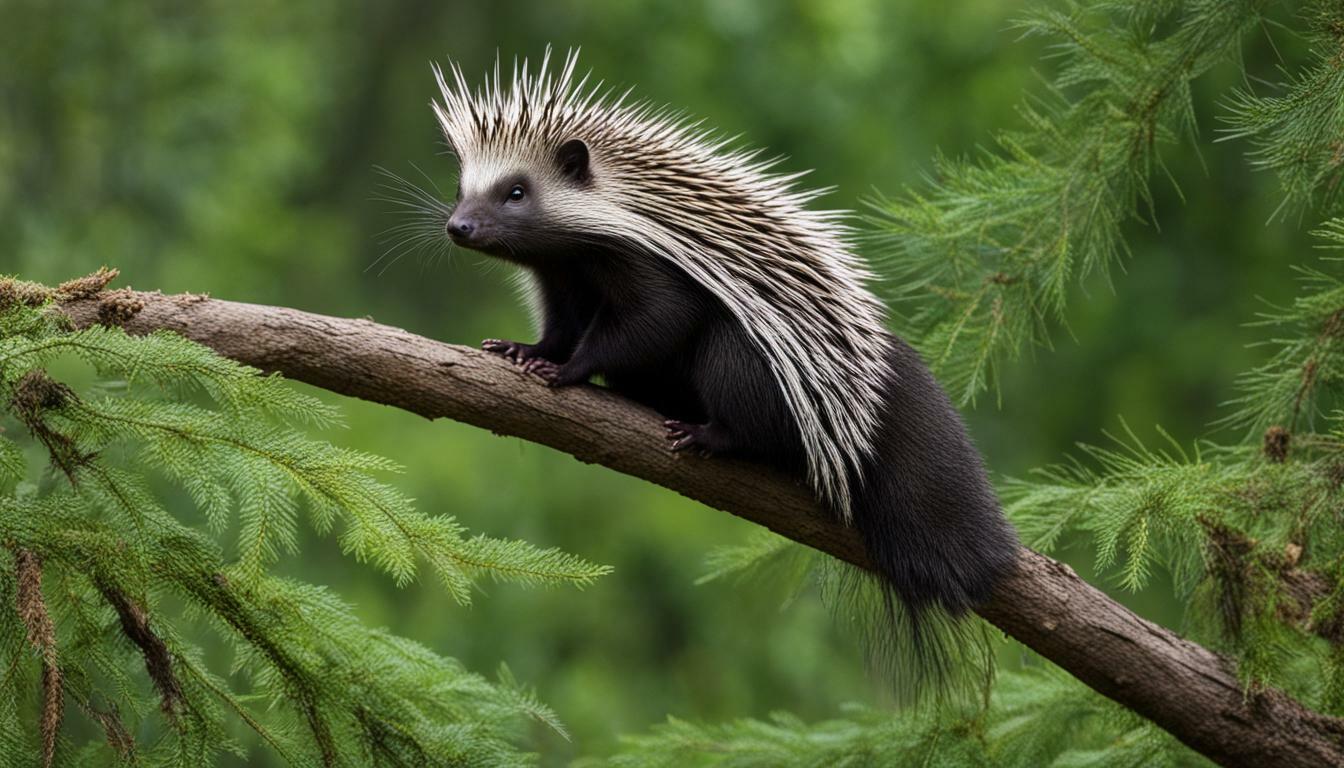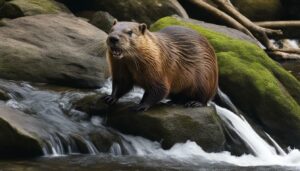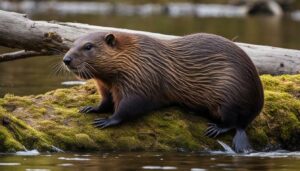Ohio is home to a diverse range of wildlife, but have you ever wondered if porcupines can be found in the Buckeye State? While porcupines are not traditionally native to Ohio, there have been sightings of them throughout the state, although they are not particularly common. Most sightings of porcupines in Ohio come from northeast counties, and they are more commonly found in neighboring Pennsylvania.
Porcupines are herbivorous and feed on small twigs, tree bark, leaves, and seeds. They are known for their spiny coat and heavy, stout body. Porcupines are comfortable in a variety of habitats but are often seen in trees. They are solitary animals and live a solitary life amongst trees and brush. Porcupines have sharp quills that help protect them from predators. They can climb trees with ease and are fascinating to observe due to their playful behavior and intelligence.
While porcupines are not considered commonplace in Ohio, the best way to observe them is at zoos or wildlife sanctuaries. These controlled environments provide a safe and educational experience for those interested in seeing porcupines up close and learning more about their unique characteristics.
Key Takeaways:
- Porcupines can be found in certain areas of Ohio, although they are not particularly common there.
- Most sightings of porcupines in Ohio come from northeast counties.
- Porcupines are more commonly found in neighboring Pennsylvania.
- Porcupines are herbivorous and feed on small twigs, tree bark, leaves, and seeds.
- They are known for their spiny coat and heavy, stout body.
The Presence of Porcupines in Ohio
While porcupines are not traditionally native to Ohio, there have been sightings of these fascinating creatures throughout the state. They are not particularly common in Ohio, but most sightings occur in the northeast counties. Porcupines are more commonly found in neighboring Pennsylvania, where they have a more established presence.
Porcupines belong to the rodent family and are known for their unique physical characteristics. They have a spiny coat, which acts as a defense mechanism against predators. Their heavy, stout body allows them to climb trees with ease, making them feel right at home in wooded areas.
These herbivorous creatures primarily feed on small twigs, tree bark, leaves, and seeds. They are comfortable in a variety of habitats but are often seen in trees, where they can access their preferred food sources. Porcupines are solitary animals and live a solitary life amongst the trees and brush, with their sharp quills providing protection from potential threats.
Observing porcupines in their natural habitat can be a rewarding experience. Their playful behavior and intelligence make them fascinating to watch. However, since porcupines are not considered commonplace in Ohio, the best way to observe them is by visiting zoos or wildlife sanctuaries that have these unique creatures on display.
| Porcupine Facts |
|---|
| • Porcupines are not traditionally native to Ohio, but there have been sightings in the state. |
| • Most porcupine sightings in Ohio occur in the northeast counties. |
| • Porcupines are more commonly found in neighboring Pennsylvania. |
| • They have a spiny coat and a heavy, stout body that allows them to climb trees. |
| • Porcupines primarily feed on small twigs, tree bark, leaves, and seeds. |
| • They are solitary animals and live a solitary life amongst trees and brush. |
Porcupine Sightings in Ohio
Porcupine sightings in Ohio have been reported, albeit not as common as in neighboring states. These fascinating creatures can be found in certain areas of Ohio, particularly in the northeast counties. However, their population is not considered commonplace throughout the state.
While porcupines are not traditionally native to Ohio, there have been numerous sightings of these unique animals. They are more commonly found in neighboring Pennsylvania, where their presence is more widespread. Despite being less frequently observed in Ohio, porcupines still capture the curiosity of wildlife enthusiasts.
Porcupines are known for their distinctive physical characteristics. They have a spiny coat and a heavy, stout body, making them easily recognizable. These herbivorous animals primarily feed on small twigs, tree bark, leaves, and seeds. They have adapted to a variety of habitats but are often seen in trees, where they display their exceptional climbing abilities.
Observing porcupines in their natural habitat can be a rewarding experience. They are solitary creatures and prefer a life amongst trees and brush. With their sharp quills as a defense mechanism, porcupines are well-equipped to protect themselves from predators. Their playful behavior and intelligence make them a captivating subject for wildlife observation.
| Key Points: | – Porcupine sightings in Ohio are not as common as in neighboring states |
|---|---|
| – Porcupines can be found in certain areas of Ohio, particularly in the northeast counties | |
| – They are more frequently observed in neighboring Pennsylvania | |
| – Porcupines have a spiny coat and a heavy, stout body | |
| – They primarily feed on small twigs, tree bark, leaves, and seeds | |
| – Porcupines are solitary creatures and are often found in trees and brush |
Habitats Preferred by Porcupines
Porcupines in Ohio are comfortable in a variety of habitats, but they are often found in trees and brush. These habitats provide them with ample food sources and protection from predators. Porcupines are herbivorous, and their diet primarily consists of small twigs, tree bark, leaves, and seeds. Their preference for trees and brush allows them to access these food sources easily.
In addition to trees and brush, porcupines can also be found in other habitats such as forests, woodlands, and even rocky areas. They have a remarkable ability to climb trees, using their sharp claws and strong limbs to maneuver effortlessly. This makes them well-adapted to arboreal living, where they can find both food and shelter. Porcupines are known to construct dens in tree hollows or crevices, further highlighting their preference for tree-dominated habitats.
While Ohio may not be the most common location to spot porcupines, they have been observed in various counties, particularly in the northeastern part of the state. However, neighboring Pennsylvania has a higher population of porcupines, making it more likely to encounter these fascinating creatures in that area. If you’re interested in observing porcupines in their natural habitat, visiting zoos or wildlife sanctuaries can provide a safe and educational experience.
| Habitats | Description |
|---|---|
| Trees | Porcupines are skilled climbers, often residing in trees where they find food and shelter. |
| Brush | The dense vegetation of brushy areas offers porcupines protection and access to their preferred food sources. |
| Forests | Porcupines can be found in forests, where they can navigate between different tree species to find suitable food options. |
| Woodlands | The mix of trees, shrubs, and open areas in woodlands provides porcupines with diverse foraging opportunities. |
| Rocky areas | Although less common, porcupines can also inhabit rocky areas, using crevices and caves as dens. |
Physical Characteristics of Porcupines
Porcupines are known for their spiny exteriors and robust physical build, making them easily recognizable among Ohio’s wildlife. These fascinating creatures have a dense coat of sharp quills covering their bodies, serving as a distinctive defense mechanism against potential predators. The quills are modified hairs that can be raised or lowered depending on the porcupine’s state of alertness or aggression.
With their stout bodies, porcupines have short legs and strong claws that enable them to climb trees with ease. This agility allows them to access their preferred habitats, which can range from forested areas to shrubby regions. Their sharp incisors are specially adapted for gnawing on small twigs, tree bark, leaves, and seeds, making them herbivorous creatures.
Table 1: Physical Characteristics of Porcupines
| Characteristic | Description |
|---|---|
| Coat | Dense, spiny quills |
| Body | Heavy and stout |
| Legs | Short with strong claws |
| Teeth | Sharp incisors for gnawing |
Porcupines are solitary creatures, spending much of their time among trees and brush. They are primarily active during the night, using their well-developed scent glands to mark their territories and communicate with other individuals. While they may appear slow-moving, porcupines possess remarkable agility and intelligence, often utilizing their dexterous paws to manipulate objects or navigate their surroundings.
If you’re interested in observing these unique creatures up close, your best bet is to visit zoos or wildlife sanctuaries that provide a safe environment for both the porcupines and the visitors. These facilities offer a rare opportunity to learn more about Ohio’s wildlife diversity and witness the intriguing behaviors of porcupines in a controlled and educational setting.
Diet and Feeding Habits of Porcupines
Porcupines in Ohio primarily feed on small twigs, tree bark, leaves, and seeds, aligning with their herbivorous diet. Their preference for these plant-based foods makes them an important part of Ohio’s wildlife preservation efforts. Porcupines play a vital role in maintaining the balance of the local ecosystem by helping control vegetation growth.
These intriguing creatures are well adapted to their herbivorous diet, with specialized teeth and strong jaws that allow them to gnaw on tough twigs and bark. Their sharp incisors are perfect for slicing through tree bark and acquiring the nutrients they need. Porcupines are particularly fond of eating the inner bark of trees, which provides them with essential nutrients and sustains their energy levels.
When it comes to feeding, porcupines exhibit selective foraging behavior. They carefully choose the types of plants they consume based on availability and nutritional value. Porcupines are known to target specific tree species, such as hemlock, beech, and oak, as well as a variety of shrubs and grasses. This selective feeding behavior ensures that they obtain the necessary nutrients from their diet and maintain their overall health in Ohio’s diverse wildlife habitats.
Adapted Diet for Survival
Porcupines have adapted to survive in Ohio’s natural landscapes by relying on their herbivorous diet. Their feeding habits and specialization in consuming woody vegetation have allowed them to thrive in various habitats, including forests and woodland areas. By consuming small twigs, tree bark, leaves, and seeds, porcupines contribute to the ecosystem’s overall balance and help regulate the growth of vegetation.
Their ability to efficiently extract nutrients from bark and twigs is a remarkable adaptation that has allowed porcupines to thrive in Ohio’s diverse environment. Despite being solitary animals, their feeding habits have a significant impact on the intricate web of life in the region. From their stout bodies to sharp quills, every aspect of a porcupine’s physical characteristics is perfectly suited to their unique diet and survival in the Ohio wilderness.
| Preferred Foods | Tree Species |
|---|---|
| Small twigs | Hemlock |
| Tree bark | Beech |
| Leaves | Oak |
| Seeds | Various shrubs and grasses |
Porcupines’ feeding habits make them captivating subjects for observation and study. If you’re eager to witness these remarkable creatures in action, consider visiting zoos or wildlife sanctuaries in Ohio. These controlled environments provide an opportunity to observe porcupines up close while ensuring their conservation and well-being. By supporting and engaging in activities that promote porcupine conservation in Ohio, we can help preserve these fascinating animals and protect the delicate balance of the state’s wildlife ecosystem.
Behavior and Lifestyle of Porcupines
Porcupines in Ohio lead solitary lives, often dwelling among trees and brush. Their behavior and lifestyle are fascinating to observe, showcasing their adaptability and unique characteristics.
Porcupines are known for their ability to climb trees with ease, using their sharp claws and strong limbs to navigate the branches. They are excellent climbers and spend a significant amount of time in trees, seeking shelter, and foraging for food. Their preference for tree-dwelling allows them to escape potential threats on the ground and find safety in elevated positions.
Despite their solitary nature, porcupines are not shy creatures. They can be quite playful, often engaging in playful behaviors such as tree branch gymnastics or gnawing on tree bark. Their playful antics and intelligence make them intriguing to observe, providing insights into their curious and adaptive nature.
Porcupines’ heavy, stout bodies are covered in sharp quills, which serve as their primary defense mechanism. When threatened, porcupines will raise their quills, making themselves appear larger and more formidable to potential predators. While their quills are effective in warding off most predators, humans and some larger predators, such as cougars and lynx, have learned to approach them with caution.
| Porcupine Behavior and Lifestyle in Ohio |
|---|
| Porcupines lead solitary lives, dwelling among trees and brush. |
| They are skilled climbers, spending a significant amount of time in trees. |
| Playful behaviors such as tree branch gymnastics are common among porcupines. |
| Their sharp quills serve as a defense mechanism against potential predators. |
“Porcupines are fascinating creatures to observe in their natural habitat. Their solitary lifestyle and tree-dwelling behavior provide a unique perspective on their adaptive nature. Watching them navigate through trees with agility and witnessing their playfulness is truly captivating.”
– Wildlife enthusiast
If you’re interested in observing porcupines in Ohio, visiting zoos or wildlife sanctuaries is your best bet. These facilities provide a controlled and safe environment for porcupines to thrive while allowing you to witness their behavior up close. Remember to respect their space and observe from a safe distance to ensure the well-being of both yourself and the porcupines.
Porcupine Quills and Protection Mechanisms
Porcupines have sharp quills that serve as a protective mechanism against potential predators, making them an intriguing sight in Ohio’s wildlife. These quills are a defining feature of porcupines and play a crucial role in their survival. When threatened, porcupines can erect their quills, creating a formidable barrier that deters predators from attacking. The quills are covered in tiny barbs that easily penetrate the flesh of any unfortunate predator that comes too close, causing pain and discomfort.
Porcupine quills are not only sharp, but they are also designed with a hollow structure that allows them to detach easily from the porcupine’s body upon contact. This unique adaptation ensures that the predator is left with a painful reminder to keep a safe distance in the future. However, contrary to popular belief, porcupines cannot actively shoot their quills at predators. Instead, the quills are passively released upon contact, relying on the predator’s movement and force to embed them further.
These fascinating quills are not only defensive weapons but also serve as a form of communication. Porcupines can rattle their quills, creating a warning sound that signals their readiness to defend themselves. The rattling sound combined with the menacing display of fully erect quills is often enough to deter predators from initiating an attack. It’s a remarkable display of adaptation and instinct that has allowed porcupines to thrive in their habitats.
Porcupine Quills Protection Mechanisms in Ohio:
| Protection Mechanism | Effectiveness in Ohio |
|---|---|
| Quill Barbs | Highly effective in deterring predators and causing pain upon contact. |
| Quill detachment | Allows for easy release and penetration, ensuring quills stay embedded in the predator’s skin. |
| Rattling sound | Serves as a warning signal, effectively deterring predators in Ohio’s wildlife. |
Porcupines’ quills and protection mechanisms are a testament to their natural adaptation and survival strategies. These unique features not only help them defend themselves but also make porcupines a captivating species to observe in Ohio’s outdoor spaces and wildlife sanctuaries.
Observing Porcupines in Ohio
If you’re interested in observing porcupines in Ohio, one of the best options is visiting zoos or wildlife sanctuaries in the state. These establishments often have designated areas or exhibits where you can see these intriguing creatures up close. Not only will you have the opportunity to observe porcupines in a controlled environment, but you will also learn more about their behavior, habits, and habitat needs.
Ohio wildlife sanctuaries, in particular, provide a natural setting where porcupines can thrive and be observed in a more authentic environment. These sanctuaries offer suitable habitats for porcupines, ensuring they have ample space, food sources, and shelter. Some sanctuaries may even have special observation areas or trails that allow visitors to catch a glimpse of these elusive animals in their natural habitat.
While porcupines are not traditionally native to Ohio, there have been sightings of them throughout the state, but they are not considered commonplace. These sightings are often concentrated in the northeast counties of Ohio, where the landscape and vegetation provide favorable conditions for porcupines. If you happen to be in these areas, keep an eye out for any signs of porcupine activity, such as chewed twigs or trees, as this might indicate their presence.
| Zoos and Wildlife Sanctuaries in Ohio | Location |
|---|---|
| Ohio Wildlife Center | Powell |
| Cleveland Metroparks Zoo | Cleveland |
| The Wilds | Cumberland |
Visiting these facilities not only allows you to observe porcupines but also supports their conservation efforts. These organizations play a crucial role in educating the public about the importance of wildlife preservation and the need to protect animal habitats. By supporting zoos and wildlife sanctuaries, you contribute to the conservation and sustainability of porcupines and other wildlife species in Ohio.
So, if you’re fascinated by these prickly creatures and want to catch a glimpse of them in Ohio, plan a trip to one of the state’s zoos or wildlife sanctuaries. Not only will you have a chance to observe porcupines up close, but you will also contribute to their conservation and deepen your understanding of Ohio’s diverse wildlife.
Porcupines in Ohio vs. Neighboring States
While porcupines can be seen in certain areas of Ohio, neighboring states like Pennsylvania have a higher population of these unique creatures. Ohio is home to the North American porcupine, scientifically known as Erethizon dorsatum. This species of porcupine is also found in other parts of the United States and Canada. However, in Ohio, their presence is not as widespread or abundant as in some neighboring states.
Porcupine sightings in Ohio are relatively uncommon, with most reports coming from counties in the northeastern part of the state. These sightings suggest that there is a small, but viable, population of porcupines residing in Ohio. However, if you are specifically interested in viewing porcupines in their natural habitat, you may have a better chance in states like Pennsylvania, where the population is more concentrated.
Porcupines are fascinating creatures known for their spiky coat and heavy, stout body. They have a herbivorous diet, mainly consisting of small twigs, tree bark, leaves, and seeds. Porcupines can adapt to various habitats, but they are often observed in trees, where they feel comfortable and secure. Their solitary nature and affinity for trees and brush make them intriguing subjects to observe and study.
If you are interested in observing porcupines, the best places to see them are at zoos or wildlife sanctuaries. These controlled environments provide a safe and educational opportunity to observe these animals up-close. While porcupines may not be as commonly seen in Ohio as in neighboring states, encountering one during your outdoor adventures in Ohio can still be a memorable experience.
| Porcupines in Ohio | Porcupines in Neighboring States |
|---|---|
| Relatively uncommon sightings | More widespread population |
| Found mainly in northeastern counties | Population concentration in certain areas |
| Small, but viable, population | Higher population numbers |
| Best observed in controlled environments like zoos and wildlife sanctuaries | Opportunity for both controlled and natural habitat observations |
The Importance of Porcupine Conservation in Ohio
Porcupine conservation plays a crucial role in maintaining Ohio’s wildlife diversity and preserving the delicate balance of the local ecosystem. While porcupines are not traditionally native to Ohio, there have been sightings of them throughout the state, although they are not considered commonplace. These sightings are often concentrated in the northeast counties of the state, and porcupines are more commonly found in neighboring Pennsylvania.
Porcupines are herbivorous animals that feed on small twigs, tree bark, leaves, and seeds. They are known for their distinctive spiny coat and heavy, stout body. Porcupines are comfortable in a variety of habitats but are often seen in trees, where they can climb with ease. Their solitary nature and affinity for trees and brush make them fascinating creatures to observe.
One remarkable feature of porcupines is their ability to protect themselves with sharp quills. These quills, when threatened or attacked, are released and can cause injury to predators. This defense mechanism helps porcupines survive in their environment and highlights the importance of preserving their habitats. By conserving porcupines and their habitats, we can ensure the long-term survival and well-being of these unique creatures.
| Key Points | Benefits of Porcupine Conservation |
|---|---|
| 1 | Preservation of Ohio’s wildlife diversity |
| 2 | Maintaining the delicate balance of the local ecosystem |
| 3 | Protection of porcupines and their habitats |
| 4 | Promotion of ecological awareness and education |
To get a closer look at porcupines in a safe and controlled environment, visiting zoos or wildlife sanctuaries is recommended. These facilities provide opportunities for education, research, and conservation efforts. By supporting these establishments, we can contribute to the preservation of porcupines and their unique place in Ohio’s wildlife landscape.
Conclusion
In conclusion, while porcupines are not commonly found in Ohio, there have been sightings of these fascinating creatures, offering a glimpse into the state’s diverse wildlife population.
Porcupines can be found in certain areas of Ohio, although they are not particularly common there. Most sightings of porcupines in Ohio come from northeast counties, and they are more commonly found in neighboring Pennsylvania.
Porcupines are herbivorous and feed on small twigs, tree bark, leaves, and seeds. They are known for their spiny coat and heavy, stout body. Porcupines are comfortable in a variety of habitats but are often seen in trees. They are solitary animals and live a solitary life amongst trees and brush.
Porcupines have sharp quills that help protect them from predators. They can climb trees with ease and are fascinating to observe due to their playful behavior and intelligence. While porcupines are not traditionally native to Ohio, there have been sightings of them throughout the state, but they are not considered commonplace. The best way to observe porcupines is at zoos or wildlife sanctuaries.
FAQ
Are porcupines commonly found in Ohio?
Porcupines are not particularly common in Ohio, but there have been sightings of them in certain areas of the state.
Where in Ohio are porcupines usually spotted?
Most porcupine sightings in Ohio come from the northeast counties. However, they are more commonly found in neighboring Pennsylvania.
What do porcupines eat?
Porcupines are herbivorous and mainly feed on small twigs, tree bark, leaves, and seeds.
What are the physical characteristics of porcupines?
Porcupines have a spiny coat and a heavy, stout body.
Where do porcupines prefer to live?
Porcupines are comfortable in a variety of habitats but are often seen in trees. They live a solitary life amongst trees and brush.
How do porcupines protect themselves from predators?
Porcupines have sharp quills that help protect them from predators.
Can porcupines be observed in Ohio?
While porcupines are not traditionally native to Ohio, there have been sightings of them throughout the state. However, the best way to observe porcupines is at zoos or wildlife sanctuaries.
Source Links
- https://www.hummingbirdsplus.org/nature-blog-network/porcupines-in-ohio-diet-lifestyle-predators-and-more/
- http://www.themountvernongrapevine.com/index.php/2019/07/25/porcupines-a-rare-visitor-to-ohio/
- https://www.dispatch.com/story/lifestyle/home-garden/how-to/2012/02/05/want-to-see-porcupine-head/23646313007/




